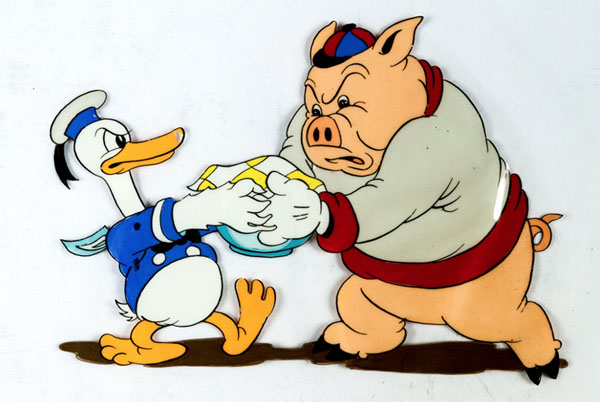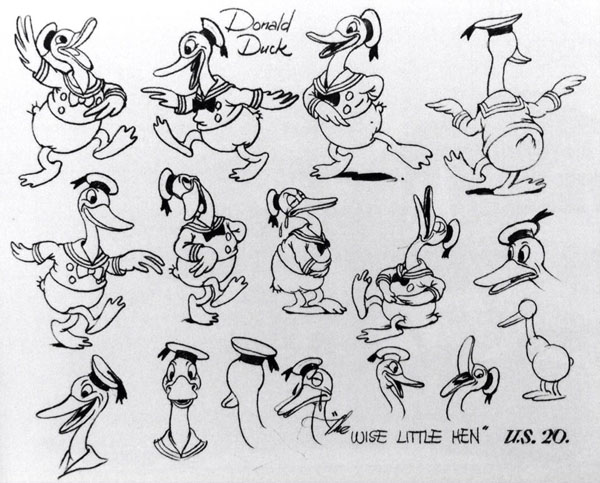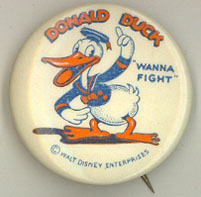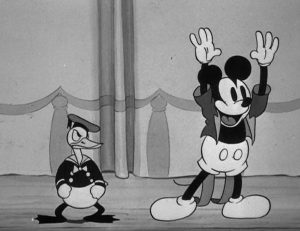
DONALD DUCK IN CLOSE UP #1
In the course of researching a major new book, my coauthor David Gerstein and I have been given an unprecedented opportunity to research anything and everything related to Donald Duck’s cartoon career. Our research has confirmed one thing we already knew: any facet of Disney history, no matter how interesting, reveals more and more fascinating details as we look at it more closely. Donald’s story is well known, but as we delve into it, we find new, unsuspected, and rich territory to explore.
One example is Donald’s origin story. Most Disney fans know the basic story of the Duck’s beginnings: Walt Disney heard a radio performer named Clarence Nash speaking in a strange, distinctive voice and was moved to hire him at the studio. In Walt’s imagination, Nash’s novelty voice suggested a talking duck, and the story crew went to work to build a character around that sound. The resulting duck was christened Donald. He made his screen debut in the Silly Symphony The Wise Little Hen, released in June 1934. Audiences were immediately taken with this unusual cartoon presence, and he was brought back as a supporting character in the Mickey Mouse series, quickly achieving a widespread popularity. Within two years he had become a leading player in his own right, threatening to eclipse Mickey himself.
 All of this is true, as far as it goes. But there’s much more to the story! To begin with, Clarence Nash had more than one trick voice up his sleeve; he actually could perform convincing imitations of a wide assortment of animals and birds. He was recruited by the Disney studio in 1931 to do just that, and worked on a freelance basis for two years before being hired as a full-time employee. His first recorded work for Disney (no pun intended) was for The Bird Store, a Silly Symphony released in January 1932. Nash was one of the performers who provided the gallery of comic bird calls in that short, and subsequently he lent his talents to a variety of other Disney pictures before joining the staff late in 1933.
All of this is true, as far as it goes. But there’s much more to the story! To begin with, Clarence Nash had more than one trick voice up his sleeve; he actually could perform convincing imitations of a wide assortment of animals and birds. He was recruited by the Disney studio in 1931 to do just that, and worked on a freelance basis for two years before being hired as a full-time employee. His first recorded work for Disney (no pun intended) was for The Bird Store, a Silly Symphony released in January 1932. Nash was one of the performers who provided the gallery of comic bird calls in that short, and subsequently he lent his talents to a variety of other Disney pictures before joining the staff late in 1933.
By that time, the Disney story department was busily at work designing a character to go with his special novelty voice. What would that character be? At this point I’m pleased to announce another of my projects: I’ve been assisting Nash’s granddaughter, Margaret Barnes, in writing a biography of Nash himself. It surprised me to learn that Nash had originally developed this now-famous voice in his youth, not to imitate a duck, but to imitate a crying baby goat! He had proceeded to amuse his friends by reciting “Mary Had a Little Lamb” in the baby goat’s voice. This act became essentially a parlor trick for several years, and practice made Nash so proficient that ultimately he could perform his specialty professionally—both for live audiences, and as a radio performer. Walt, on hearing the voice, pictured the character as a duck rather than a goat; and Nash, being an agreeable sort (unlike Donald!), went along with that idea.

As the Disney story artists worked to develop this character, documents preserved in the Walt Disney Archives reveal that they were thinking of the duck as a little boy. Perhaps influenced by Nash’s conception of the goat as a baby goat, they pictured the duck in very young terms as well. A rudimentary character began to take shape, and the writers devised a story outline with a spot for him. The story was for a Mickey Mouse short, to be known as “The Surprise Party,” and would depict a party at which Mickey and other characters would perform musical numbers and other improvised acts. One of the guests at the party was the little duck, fussed over by a doting mother. “The little duck character will be dragged in by his mother,” said the outline, “and made to recite ‘Mary Had A Little Lamb’”—preserving on film the specialty that Clarence Nash had been rehearsing for years.
 I try to be very careful about using the word “first,” but “The Surprise Party” appears to be the first story outline that the Disney writers developed for the new duck character. It’s not difficult to picture the little fellow in this scenario, busily fretted over by his stage mother. This idea, in fact, may be the real origin of the Duck’s sailor suit; cute little outfits of this kind were a common affectation for overindulged children at the time. The story department continued to develop the “Surprise Party” outline, and it wasn’t until a week or two later that they circulated a separate outline for a version of the traditional children’s story “The Little Red Hen.” This second story, of course, would ultimately be completed and released as The Wise Little Hen, and would afford Donald his true screen debut—playing an “adult” character, more or less. (Readers of Cartoon Research are probably aware that Disney changed the title to avoid confusion with Ub Iwerks’ cartoon version of the same story, which retained the title The Little Red Hen and was released in February 1934.)
I try to be very careful about using the word “first,” but “The Surprise Party” appears to be the first story outline that the Disney writers developed for the new duck character. It’s not difficult to picture the little fellow in this scenario, busily fretted over by his stage mother. This idea, in fact, may be the real origin of the Duck’s sailor suit; cute little outfits of this kind were a common affectation for overindulged children at the time. The story department continued to develop the “Surprise Party” outline, and it wasn’t until a week or two later that they circulated a separate outline for a version of the traditional children’s story “The Little Red Hen.” This second story, of course, would ultimately be completed and released as The Wise Little Hen, and would afford Donald his true screen debut—playing an “adult” character, more or less. (Readers of Cartoon Research are probably aware that Disney changed the title to avoid confusion with Ub Iwerks’ cartoon version of the same story, which retained the title The Little Red Hen and was released in February 1934.)
 In the meantime, the Disney writers continued to work on “The Surprise Party.” By the time the film was completed and released in August 1934, it had been completely transformed. Now the private party became a theatrical performance, for an audience of rowdy little mice, and the film’s title was changed to Orphans’ Benefit. But Donald retained his spot in the program—and, as advertised, he did recite “Mary Had a Little Lamb.”
In the meantime, the Disney writers continued to work on “The Surprise Party.” By the time the film was completed and released in August 1934, it had been completely transformed. Now the private party became a theatrical performance, for an audience of rowdy little mice, and the film’s title was changed to Orphans’ Benefit. But Donald retained his spot in the program—and, as advertised, he did recite “Mary Had a Little Lamb.”
Further appearances followed soon after, and the idea of depicting Donald as a child was soon forgotten. But for any viewer of Orphans’ Benefit who has ever wondered why early Donald appears so short when standing onscreen next to Mickey Mouse in this film, that first story outline may provide one answer. And the notion of Donald as a little boy didn’t instantly disappear; vestiges of the idea continued to turn up for years afterward. As late as 1938, in Donald’s Better Self, he was pictured as a schoolboy, urged to go to school and simultaneously tempted to play hooky and go fishing instead.
NEXT MONTH: The Other “Duck Man”


 J.B. Kaufman is an author and film historian who has published and lectured extensively on Disney animation, American silent film history, and related topics. He is coauthor, with David Gerstein, of the Taschen book “Walt Disney’s Mickey Mouse: The Ultimate History,” and of a forthcoming companion volume on Donald Duck. His other books include “The Fairest One of All,” “South of the Border with Disney,” “The Making of Walt Disney’s ‘Fun and Fancy Free’,” and two collaborations with Russell Merritt: “Walt Disney’s Silly Symphonies” and the award-winning “Walt in Wonderland: The Silent Films of Walt Disney.”
J.B. Kaufman is an author and film historian who has published and lectured extensively on Disney animation, American silent film history, and related topics. He is coauthor, with David Gerstein, of the Taschen book “Walt Disney’s Mickey Mouse: The Ultimate History,” and of a forthcoming companion volume on Donald Duck. His other books include “The Fairest One of All,” “South of the Border with Disney,” “The Making of Walt Disney’s ‘Fun and Fancy Free’,” and two collaborations with Russell Merritt: “Walt Disney’s Silly Symphonies” and the award-winning “Walt in Wonderland: The Silent Films of Walt Disney.”







































I have heard the story of Nash taking the Donald voice from a goat before, so I’m surprised that you’re surprised.
On an unrelated note, I got your latest book “The Making of Fun and Fancy Free” for Christmas and it is a gorgeous, informative book. Congratulations, and keep up the good work!
Thank you, Tony!
Huge fan of both you and David so looking forward to your forthcoming book. Loved the expensive Mickey Mouse book and loved your individual work on the Fun and Fancy Free book.
The sailor suit was the first popular children’s fashion trend. The impulse that set the ball in motion was Queen Victoria’s decision to dress the four-year Prince of Wales, Albert Edward, in a scaled down version of the sailor suit of the Royal British Navy. The young Prince wore the sailor suit on the royal family’s visit to the Channel Islands in 1846. His portrait was painted at the same time. The portrait, as well as a series of engravings, helped to popularize the sailor suit among the British public.
The sailor suit did not become a popular fashion trend for children overnight. British boys began wearing sailor suits in the 1860s, fifteen years after Prince Edward’s portrait. Prince Edward began dressing his own sons in sailor suits in the 1870s and, once again, the influence of the royal family helped to popularize the sailor suit for young children. The fashion trend really took root in the 1870s when advertisers began marketing it. By the 1880s the sailor suit was a popular fashion trend for girls as well as boys. The sailor suit became so popular in the 1880s that few boys grew up in England without wearing it and, for some, was practically all they wore. The trend migrated to the United States and was popular when Walt Disney was a kid.
Also check out FOWL AFFAIR ([Al Christie]) bw-(2R)-(Gayety Comedy)-©-Apr 20, 1931 with a live duck wearing a sailor suit similar to Donald and used in advertisements for the film.. By the way, Donald’s sailor suit was not for the American navy but similar to one worn by French sailors and used in musical productions on Broadway at the time because it was so distinctive.
All of this information comes from notes for a book I was planning to write about all things Donald called JUST DUCKY that I put away when my book about Mickey Mouse, BOOK OF MOUSE, did not sell well.
It was also my understanding that Walt said he and the writers at the studio were originally thinking of a female duck character and struggling with the idea.
As Walt Disney said, “In America, we are guaranteed these freedoms. It is the constitutional privilege of every American to become cultured or to grow up like Donald Duck.” His wife Lillian, by the way, did not care for Donald at all as mentioned in Bob Thomas’ biography of Walt.
Thank you, Jim, for all that additional background on the sailor-suit custom. Of course Walt, in later interviews, always attributed Donald’s sailor suit to a duck’s fondness for water — and it’s entirely possible that BOTH considerations were involved in this. Films always reflect the culture that produces them!
We have a wonderful photo in our family collection of two of my uncles as pre-teens decked out in full sailor array posed with their family – staunchly middle-class folk – in front of their San Francisco home, recently rebuilt after the 1906 earthquake and fire. Though I’ve known about the old kid sailor suit fashion for a long time I’d never put 2 + 2 together vis-à-vis Donald’s outfit. I’m really looking forward to the upcoming Kaufam/Gerstein book.
Thank you, Paul. I think you’ll enjoy it — David has really outdone himself in delving into the history of Donald’s comics.
Having learned about the “Surprise Party” treatment, I can only imagine the scene of Donald being pushed by his mother to recite “Mary Had a Little Lamb” is staged similarly to I HAVEN’T GOT A HAT, with Little Kitty performing the same action in the schoolhouse. I wouldn’t be surprised if the scene ended the same way with little Donald making an exit and frantically running to an outhouse! (If Jack King was at the Disney studio while “Surprise Party” was being outlined, he could have remembered that unused treatment and pitched the idea for the sequence to Friz Freleng at Warners.)
Thank you, Devon. Yes, you’re right, there is a real similarity between those two scenes. And it is tempting to think that Jack King carried the idea with him to WB. Unfortunately his Disney personnel record indicates that he left in May 1933, a good six months before the “Surprise Party” outline was written — but of course he was still acquainted with his former (and future) Disney colleagues, so who knows, it’s still possible that he was aware of their plans.
Thanks, JB and David, for all that you do. Currently reading (and highlighting with yellow marker! Bye bye resale value!) your superb large Mickey book and can’t WAIT for this one. Thanks again!
Was fortunate enough to meet Clarence “Ducky” Nash where he called me by name in Donald’s voice. It was a thrilling moment from a very kind man.
Thank you, Kevin, and thanks for sharing that memory. Yes, it’s been a pleasure to discover what a friendly, outgoing, down-to-earth individual Nash was. Glad you got to meet him!
Some years ago I saw a special museum exhibit on the history of the sailor suit in fashion (which was actually a lot more interesting than it sounds). There were some vintage Donald Duck and Popeye movie posters and comic books… but no Sailor Moon!
Thanks for a “ducky” post, as my mother used to say.
Thank you, Paul!
Years ago, the New Yorker did a long, affectionate profile of Clarance Nash. Don’t recall the year, but when Nash took the interviewer into the Disney studio some story men seized them as an audience. They were talking about Bernard and Bianca from the in-production “Rescuers”.
Thank you! Yes, for years that was one of Nash’s roles at the studio — whenever he wasn’t actually recording, he was available to escort visitors on studio tours. He was naturally gregarious and enjoyed doing that.
The New Yorker’s Profile of Clarence Nash ran in the December 29, 1975 issue.
On Burns and Allen rdio show Gracie had a goose whose noises sounded like Clarence Nash. It might beenthe show Walt heard.
Actually the Burns & Allen episodes came after he was already established as Donald Duck’s voice, but you’ve got a good ear; that was definitely Clarence. As it turns out, he had a substantial radio career simultaneously with his work for Disney.
Talking about kiddy outfits, Pop (of Rice Krispies fame) wears a scaled down soldier outfit.
Goat? Duck? MGM did a cartoon where a similar voice was given to a housecat.
I believe you’re thinking of “Ventriloquist Cat” (Avery, 1950). The cat was voiced by nightclub comedian Red Coffey, who also voiced Little Quacker in the Tom and Jerry cartoons as well as numerous H-B cartoon ducks in the sixties (but not Yakky Doodle). His “Meow meow!” does have a distinctly anatine quality.
Paul, I think Brad is referring to The Alley Cat (1941).
i would sure luv to see where that iconic Donald vent puppet landed these days!!
There is a story from 2012:https://kfor.com/2012/05/07/great-state-okie-donald-duck/
Really fascinating, Mr. Kaufman. By the way, I was born the same year–1985–that Clarence Nash, along with C. L. Hartman, Bill Scott, and Joe Oriolo, died.
I’ve been waiting for a Donald/Ducky Nash history book to come along. I have the other book on Jack Hannah.
JB: I love your Disney History books – Pinocchio (“The Epic”) is still my top favorite book, along with “Fairest Of Them All”.
Jim Korkis: You were gonna do a Donald Book?! You should totally release it, I would love to read that book!
Thank you for your kind words, Mason!
Hey JB,
Nicely done! As always! Bravo!
-Tony
Many thanks, Tony!
@JB Kaufman You’re welcome, looking forward to Donald’s history being told, always thought Donald was Roy’s alter ego
Thank you for your upcoming book about Nash and his work in the Disney Studios. Is it like to be published in 2020? (Your book on Disney in South America is outstanding.)
Have Nash’s two daughters been available for input, recollections, and memories? I am curious also if Mr. Anselmo’s experiences with Nash also be a part of the publication?
Thanks!
I can’t find the 1931 live-action short film now, I’ll find the short if it’s on YouTube.
The film is possibly, if not lost, I tried to search the short film, but it got me the link of this post and list of various shorts in TCM forums, I’m sorry but I can’t find it right now, put video links next time.